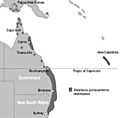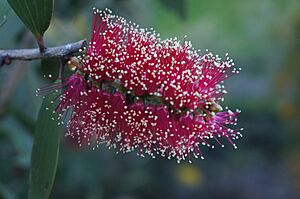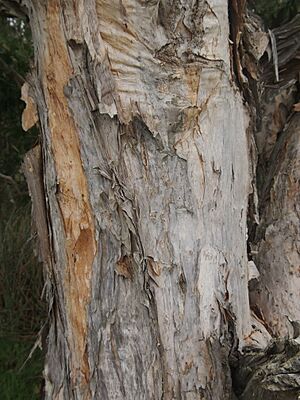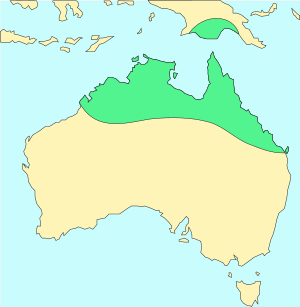Broad-leaved paperbark facts for kids
Quick facts for kids Broad-leaved paperbark |
|
|---|---|
 |
|
| M. viridoflora near Canal Creek, Queensland | |
| Scientific classification | |
| Genus: |
Melaleuca
|
| Species: |
viridiflora
|
The Melaleuca viridiflora, also known as the broad-leaved paperbark, is a type of plant in the Myrtaceae family, which includes plants like eucalyptus. This tree naturally grows in woodlands, swamps, and along streams in the northern parts of Australia and New Guinea. These areas often have a monsoon climate, meaning they get a lot of rain during certain times of the year.
The broad-leaved paperbark is usually a small tree. It has a fairly open shape, and its bark feels like paper. Its flowers can be cream, yellow, green, or red, and they grow in spikes.
Contents
What Does It Look Like?
The Melaleuca viridiflora can be a shrub or a small tree. It usually grows up to about 10 meters (33 feet) tall, but sometimes it can be twice that height. It has bark that can be white, brownish, or grey, and it feels papery. The tree has an open shape, meaning its branches are not too dense.
Its leaves are quite large, measuring about 7 to 19.5 centimeters (2.8 to 7.7 inches) long and 1.9 to 7.6 centimeters (0.75 to 3.0 inches) wide. They are thick, oval-shaped, and smell nice.
The flowers of this tree can be cream, yellow, yellow-green, or sometimes red. They grow in spikes at the ends of the branches. These branches keep growing even after the flowers have bloomed. Sometimes, flowers also grow where the leaves meet the stem. Each flower spike can be up to 10 centimeters (3.9 inches) long and 5.5 centimeters (2.2 inches) across. Each spike has 8 to 25 groups of flowers, with three flowers in each group.
The petals of the flowers are about 4 to 5.3 millimeters (0.16 to 0.21 inches) long. They fall off as the flower gets older. Inside the flower, there are five groups of stamens (the parts that produce pollen). Each group has 6 to 9 stamens, but they are not very strongly joined together.
You can see these flowers at any time of the year, but they are most common in winter. After the flowers bloom, the tree produces woody capsules, which are like small, hard seed pods. These capsules are about 5 to 6 millimeters (0.20 to 0.24 inches) long and are scattered along the stem. Each capsule holds many tiny seeds.
How It Got Its Name
The Melaleuca viridiflora was first officially described in 1788 by a scientist named Daniel Solander. His description was published by Joseph Gaertner in a book called De fructibus et seminibus plantarum. This book even included a detailed drawing of the flower parts and seed pods.
The description was made when the famous ship Endeavour, led by Captain James Cook, had to stop for repairs. They were on the banks of the Endeavour River, where the town of Cooktown is today.
The second part of the plant's scientific name, viridiflora, comes from two Latin words. Viridis means "green," and flos means "flower." This name refers to the fact that the most common color for the flowers of this tree is green.
Where It Grows
This type of melaleuca tree grows in the warm, tropical parts of Australia. You can find it as far south as Maryborough in Queensland, in the northern areas of Western Australia (down to the Dampier Peninsula), and in the northern half of the Northern Territory. It also grows in the southern part of West Papua in Indonesia and in southern Papua New Guinea.
It likes to grow at the edges of forests, in woodlands, and in swampy flat areas. It can grow in many different types of soil.
Its Role in Nature
Forests of Melaleuca viridiflora provide a home for many different types of orchids. Some of these orchids are rare or even endangered.
Often, individual Melaleuca viridiflora trees host a special plant called an "ant-house plant" (Myrmecodia beccarii). This plant grows on other plants (it's an epiphyte) and has hollow parts where ants can live.
It's interesting to note that some plants that were brought to south-eastern Florida in the 1900s and called Melaleuca viridiflora were later found to be a different species, Melaleuca quinquenervia.
Uses of the Tree
Traditional Uses
Aboriginal Australians have used the Melaleuca viridiflora tree for many different things. The bark can be peeled off in layers. They used this papery bark to make shelters, bedding, containers, and even for storing and cooking food. It was also used as tinder to start fires, to build watercraft (like canoes), and to make fish traps.
In traditional medicine, a special drink made from the leaves was used. People would drink it, breathe in its steam, or use it for bathing to help treat coughs, colds, stuffy noses, headaches, fevers, and the flu.
Essential Oils
Different groups of Melaleuca viridiflora trees produce different kinds of oils. However, there are two main types of oils. One type is rich in a substance called terpenic oil. The other type is rich in methyl cinnamate. These oils have different chemical makeups.
Gardening
The Melaleuca viridiflora is a useful and adaptable small tree for gardens. The variety with red flowers is especially popular. It grows well in tropical and subtropical areas that get a lot of rain in the summer, especially in heavy clay soils. Because it has an open shape, it's a good tree to host other plants that grow on it, like Dendrobium orchids.
Images for kids
-
Red-flowered form in Brisbane Botanic Gardens
-
White form in New Caledonia
See also
 In Spanish: Niaulí para niños
In Spanish: Niaulí para niños











